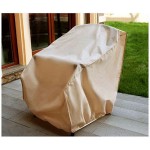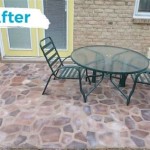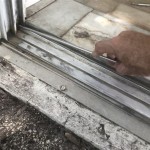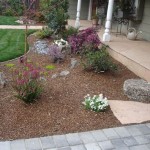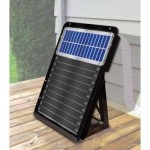How to Replace a Glass Top Patio Table with Wood
Many patio tables feature glass tops for their sleek aesthetic and ease of cleaning. However, glass can be prone to shattering, especially in outdoor environments with fluctuating temperatures and potential impacts. Replacing a damaged or simply unwanted glass top with wood offers a durable and customizable alternative, enhancing the table's functionality and visual appeal. This article provides a comprehensive guide on how to successfully replace a glass patio table top with a wooden one.
Before commencing the replacement, careful consideration should be given to factors such as the table frame's construction, the desired wood species, and the necessary tools and materials. Planning and preparation are crucial for a smooth and successful conversion.
Assessing the Existing Table Frame
The first step involves a thorough assessment of the existing patio table frame. The frame's design will dictate the approach to attaching the new wooden top. Most patio tables use one of three frame designs:
1. Solid Perimeter Frame: This design features a continuous frame around the entire perimeter of the table. It is the simplest to work with, as the wooden top can be easily attached to the existing frame using screws or bolts.
2. Individual Leg Supports: These tables have legs that are connected directly to the tabletop without a full perimeter frame. Replacing the top on these tables requires careful planning to ensure adequate support for the wooden surface. Additional cross-bracing might be necessary to prevent sagging or instability.
3. Center Support Frame: Some tables have a central support structure, often a ring or a series of crossbars, supporting the glass top. This design requires the wooden top to be attached securely to the central support, which may involve creating a custom mounting system.
Carefully examine how the original glass top was attached. Some glass tops are simply held in place by rubber bumpers or suction cups, while others are secured with adhesive or metal clips. Note any existing hardware or mounting points that can be reused for the wooden top.
Measure the dimensions of the existing glass top precisely. These measurements will serve as the template for the new wooden top. Account for any overhang or lip that the glass top had. Accurate measurements are critical for a proper fit.
Selecting the Appropriate Wood
The choice of wood is paramount for the longevity and aesthetic appeal of the patio table. Several factors influence the selection process, including durability, resistance to weather, and personal preference regarding appearance.
1. Wood Species:
Teak: Teak is renowned for its exceptional durability and natural resistance to moisture, decay, and insects. Its high oil content makes it ideal for outdoor use, without requiring frequent sealing or staining. Teak develops a silver-gray patina over time, which many find aesthetically pleasing. However, teak is typically more expensive than other wood options.
Cedar: Cedar possesses natural insect-repelling properties and good resistance to decay. It is lighter and more affordable than teak but still performs well outdoors. Cedar requires regular sealing or staining to maintain its color and prevent weathering.
Cypress: Cypress is another durable softwood that is naturally resistant to decay and insects. It is often used in outdoor applications due to its ability to withstand wet conditions. Cypress is also relatively affordable and can be easily stained or painted.
Redwood: Redwood is known for its beautiful reddish-brown color and natural resistance to decay and insects. It is a relatively soft wood, making it easier to work with, but it may require more frequent sealing or staining to protect it from the elements. Availability and cost can vary depending on the region.
Pressure-Treated Lumber: Pressure-treated lumber is softwood that has been chemically treated to resist decay and insect infestation. It is a cost-effective option for outdoor use but may not be as aesthetically pleasing as natural hardwoods. Pressure-treated lumber should be sealed or painted to prevent the chemicals from leaching out and to protect the wood from moisture.
2. Wood Thickness: The thickness of the wood is crucial for the table's stability and load-bearing capacity. A thickness of at least 1 inch (2.5 cm) is recommended for most patio tables. For larger tables or those that will bear heavy loads, a thicker wood (1.5 to 2 inches) may be necessary.
3. Wood Preparation: Before cutting and assembling the wooden top, ensure the wood is properly prepared. This includes:
Kiln-drying: Kiln-dried wood has been dried in a controlled environment to reduce its moisture content, minimizing warping and cracking. Using kiln-dried wood is essential for outdoor applications.
Planing: Planing the wood ensures a smooth and uniform surface, making it easier to join the boards and apply finishes.
Sanding: Sanding the wood creates a smooth surface for finishing and helps to highlight the wood's natural grain. Start with a coarse grit sandpaper (80-100 grit) and gradually work your way up to a finer grit (180-220 grit).
Constructing and Installing the Wooden Table Top
Once the wood has been selected and prepared, the construction process can begin. This involves cutting the wood to size, joining the boards, and attaching the top to the table frame.
1. Cutting the Wood: Using the measurements taken from the original glass top, cut the wood to the required dimensions. If the tabletop consists of multiple boards, cut each board to the appropriate width and length. Precision is important to ensure a seamless and uniform surface.
2. Joining the Boards: Several methods can be used to join the boards together to create the tabletop:
Butt Joints: Butt joints are the simplest type of joint, where the edges of the boards are simply placed together and fastened with screws or nails. However, butt joints are not very strong and can be prone to failure. It is generally best to avoid butt joints for outdoor applications.
Pocket Hole Joints: Pocket hole joints use angled screws to join the boards together. This method is relatively easy to learn and provides a strong and durable connection. Pocket hole jigs are available at most woodworking stores and make it easy to drill the angled holes.
Edge Joints: Edge joints involve gluing the edges of the boards together to create a wider panel. This method requires careful clamping to ensure a strong and seamless bond. Edge joints are best suited for indoor applications or when used in conjunction with other reinforcement methods.
Tongue and Groove Joints: Tongue and groove joints feature interlocking profiles that create a strong and aesthetically pleasing connection. These joints are more complex to create but offer superior strength and stability.
Apply wood glue to the edges of the boards before joining them. Use clamps to hold the boards together until the glue has dried completely (typically 24 hours). Wipe away any excess glue with a damp cloth.
3. Attaching the Top to the Frame: Once the wooden top has been assembled, it can be attached to the patio table frame. The attachment method will depend on the design of the frame:
Solid Perimeter Frame: Drill pilot holes through the frame and into the underside of the wooden top. Use stainless steel screws to fasten the top to the frame. Stainless steel screws are essential for outdoor applications to prevent rust and corrosion.
Individual Leg Supports: If the table has individual leg supports, consider adding a subframe to the underside of the wooden top. The subframe will provide additional support and a surface to which the legs can be attached. Construct the subframe from the same wood species as the tabletop and attach it using screws and glue.
Center Support Frame: For tables with a center support frame, create a custom mounting system that allows the wooden top to be securely attached to the support. This may involve using metal brackets or custom-fabricated hardware.
4. Finishing the Wood: After attaching the top, apply a suitable finish to protect the wood from the elements. Several options are available:
Sealer: A sealer helps to protect the wood from moisture and UV damage. Apply several coats of sealer, following the manufacturer's instructions.
Stain: Staining the wood allows you to customize its color and enhance its natural grain. Choose a stain that is specifically designed for outdoor use.
Paint: Painting the wood provides a durable and weather-resistant finish. Use an exterior-grade paint and apply several coats for optimal protection.
Spar Varnish: Spar varnish is a flexible and durable finish that is designed for marine applications. It provides excellent protection from moisture and UV damage and is a good choice for outdoor furniture.
Apply the finish evenly, using a brush or a sprayer. Allow each coat to dry completely before applying the next. Lightly sand the surface between coats to create a smooth and uniform finish.
By following these steps, a damaged or unwanted glass top on a patio table can be replaced with a durable and aesthetically pleasing wooden surface, significantly improving the table's functionality and overall lifespan. Proper planning, material selection, and construction techniques are key to achieving a successful and long-lasting result.

Makeover An Outdoor Table And Refresh Chairs Deeply Southern Home

Upcycle Broken Glass Patio Table With Wood

Broken Garden Table Upcycle Repair With Diy Drinks Wells

How To Replace A Glass Tabletop With Rustic Wood Tray Painted Outdoor Furniture Pallet

Makeover An Outdoor Table And Refresh Chairs Deeply Southern Home

Converting Our Broken Glass Patio Table Into A Beautiful Wooden

Diy Replace Glass Tabletop With Tile Weekend Warrior Wednesday Your Modern Family

Replacement Top For Patio Table After Glass Shattered Diy Furniture Makeover

Diy Replace Glass Tabletop With Tile Weekend Warrior Wednesday Your Modern Family

New Wooden Top For The Patio Table To Replace Glass That Broke Great Job Matt Redo Furniture


